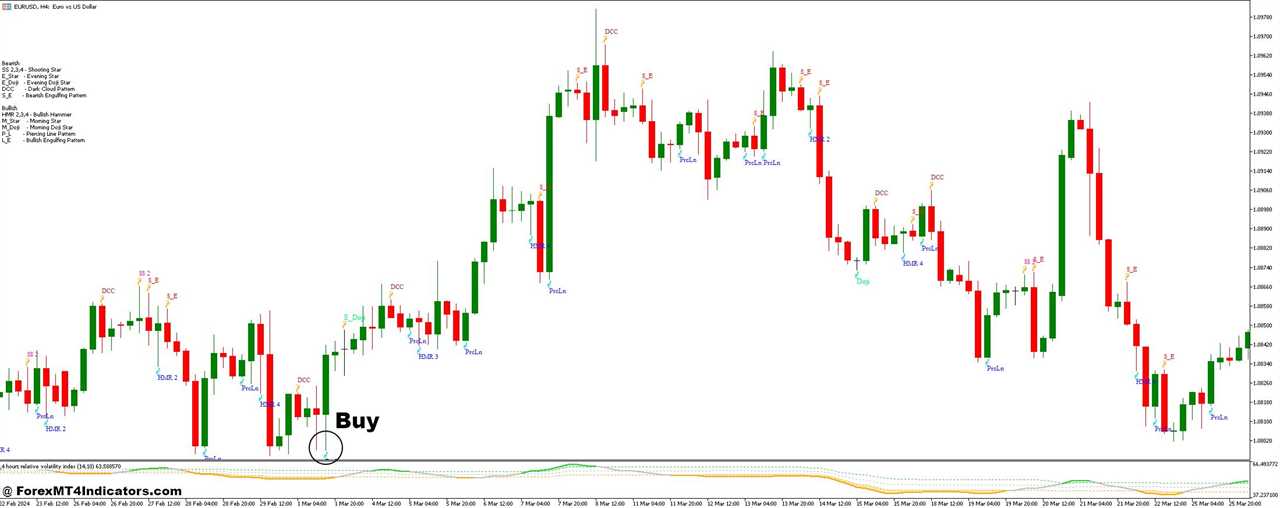||
Relative Volatility Index and Japanese Candlestick Forex Trading Strategy combines two powerful tools that can help traders better navigate the complexities of the forex market. The Relative Volatility Index (RVI) measures the direction of market volatility, giving insight into whether the market is gaining strength or losing momentum. On the other hand, Japanese candlestick patterns offer a visual representation of price action and trader sentiment, helping traders spot potential reversals or continuation patterns. Together, these two elements create a strategy that allows for more informed trading decisions based on both price behavior and volatility.
What makes this combination effective is the way these tools complement each other. The RVI helps to confirm the strength of a trend, filtering out some of the noise that can often mislead traders when relying solely on candlestick patterns. While Japanese candlestick patterns are excellent at highlighting shifts in market sentiment, they can sometimes signal false reversals or continuations. Adding the RVI helps verify whether the market is truly gaining momentum or simply experiencing a short-term fluctuation, making it easier to spot high-probability trades.
In practice, this strategy is particularly useful for traders who prefer to trade with more confidence, as it offers a balanced approach between technical indicators and price action analysis. By focusing on both volatility and candlestick patterns, traders can reduce the likelihood of entering trades during indecisive market conditions. This combination allows traders to better time their entries and exits, ultimately leading to more consistent results in the fast-moving forex market.
Relative Volatility Index Indicator
The Relative Volatility Index (RVI) is a technical indicator that helps traders assess the volatility of a financial instrument in relation to its price movement. It is designed to identify the strength of a trend by measuring how much price fluctuates within a given period. Unlike traditional volatility indicators that focus solely on price ranges, the RVI also considers the direction of price changes, providing a clearer picture of market sentiment. The RVI typically ranges from 0 to 100, with higher values indicating stronger volatility.
One of the key advantages of the RVI is its ability to filter out market noise, helping traders to avoid false signals and focus on genuine trends. When the RVI is above 50, it suggests that the price is more volatile in an upward direction, while a reading below 50 indicates greater downward volatility. This feature makes the RVI particularly useful for confirming the strength of bullish or bearish trends, allowing traders to make more informed decisions about entry and exit points. Moreover, the RVI can be applied in various trading styles, from day trading to swing trading, providing flexibility in different market conditions.
To effectively use the RVI, traders often look for divergences between the RVI and price action. For instance, if the price makes a new high but the RVI fails to reach a new high, this could signal a potential trend reversal. Conversely, if both the price and RVI are moving in the same direction, it strengthens the case for continuing with the current trend. Overall, the Relative Volatility Index is a valuable tool for forex traders seeking to navigate the complexities of market volatility and make well-timed trading decisions.
Japanese Candlestick Indicator
Japanese candlesticks are a popular charting technique that provides visual insight into market sentiment and price action over specific periods. Each candlestick represents four essential pieces of information: the opening price, closing price, high, and low within a given time frame. The body of the candlestick illustrates the difference between the opening and closing prices, while the wicks (or shadows) show the highest and lowest prices reached during that period. This format enables traders to quickly assess whether buyers or sellers dominated the market during that time.
One of the significant advantages of using Japanese candlesticks is their ability to reveal patterns that indicate potential market reversals or continuations. Traders often look for specific formations, such as Dojis, Engulfing patterns, and Hammer or Shooting Star patterns, which can provide insight into market psychology. For example, a Doji indicates indecision among traders, suggesting that a reversal might be on the horizon, while an Engulfing pattern can signal a strong shift in momentum. These patterns, when combined with other indicators like the RVI, can enhance the accuracy of trading signals.
Japanese candlesticks also facilitate a more intuitive understanding of market dynamics. By visually representing price movements, traders can gauge the emotional state of the market—whether it’s fear, greed, or indecision—helping them to make more informed decisions. This indicator is versatile and can be applied across different time frames, making it suitable for various trading strategies, from scalping to long-term investing. Overall, Japanese candlestick patterns are an essential tool for forex traders looking to interpret price action and gain a deeper understanding of market behavior.
How to Trade with Relative Volatility Index and Japanese Candlestick Forex Trading Strategy
Buy Entry

- Identify Trend: Ensure the RVI is above 50, indicating a bullish trend.
- Look for Confirmation: Wait for a bullish candlestick pattern, such as:
- Bullish Engulfing: A green candlestick engulfs the previous red candlestick.
- Hammer: A small body with a long lower wick, showing buyer strength.
- Entry Point: Place a buy order just above the high of the confirming candlestick.
- Stop-Loss: Set a stop-loss order below the low of the confirming candlestick to manage risk.
- Take Profit: Determine a target level based on recent resistance levels or a risk-reward ratio (e.g., 1:2).
Sell Entry

- Identify Trend: Ensure the RVI is below 50, indicating a bearish trend.
- Look for Confirmation: Wait for a bearish candlestick pattern, such as:
- Bearish Engulfing: A red candlestick engulfs the previous green candlestick.
- Shooting Star: A small body with a long upper wick, indicating potential selling pressure.
- Entry Point: Place a sell order just below the low of the confirming candlestick.
- Stop-Loss: Set a stop-loss order above the high of the confirming candlestick to manage risk.
- Take Profit: Determine a target level based on recent support levels or a risk-reward ratio (e.g., 1:2).
Conclusion
The Relative Volatility Index and Japanese candlestick patterns together create a robust trading strategy that can enhance decision-making in the forex market. By understanding how to interpret volatility and price action, traders can gain a clearer insight into market dynamics, increasing their chances of success. This strategy not only allows traders to identify potential entry and exit points more confidently but also helps them manage risks effectively.
Recommended MT4 Broker
XM Broker
- Free $50 To Start Trading Instantly! (Withdraw-able Profit)
- Deposit Bonus up to $5,000
- Unlimited Loyalty Program
- Award Winning Forex Broker
- Additional Exclusive Bonuses Throughout The Year
- Exclusive 50% Cash Rebates for all Trades!

>> Sign Up for XM Broker Account here with Exclusive 50% Cash Rebates For All Future Trades [Use This Special Invitation Link] <<
Already an XM client but missing out on cashback? Open New Real Account and Enter this Partner Code: 𝟕𝐖𝟑𝐉𝐐
Click here below to download:
Save
Save
Get Download Access
||
-----------------------------------------------------
By: Tim Morris
Title: Relative Volatility Index and Japanese Candlestick Forex Trading Strategy
Sourced From: forexmt4indicators.com/relative-volatility-index-and-japanese-candlestick-forex-trading-strategy/?utm_source=rss&utm_medium=rss&utm_campaign=relative-volatility-index-and-japanese-candlestick-forex-trading-strategy
Published Date: Fri, 08 Nov 2024 01:00:14 +0000
Read More
Did you miss our previous article...
https://peaceofmindinvesting.com/tools/volume-average-percent-mt5-indicator
.png) InvestingStocksToolsClubsVideosPrivacy PolicyTerms And Conditions
InvestingStocksToolsClubsVideosPrivacy PolicyTerms And Conditions
